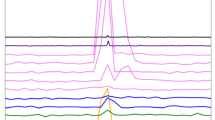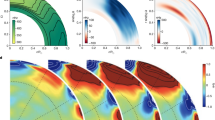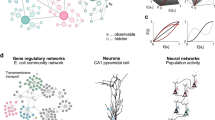Abstract
QUASARS have been found up to redshifts of almost five, corresponding to an epoch when the Universe was less than ten per cent of its present age. This leaves a rather short time for the formation of the galaxies in which quasars are believed to be embedded. Indeed, some optical studies1–3 indicate that the space density of quasars does decline rapidly for redshifts z > 3, as expected if this is the epoch of galaxy formation. The interpretation of this decline is equivocal, however, as it could result simply from the obscuration of distant quasars by dust in intervening galaxies4. Radio emission from quasars, on the other hand, is unaffected by dust, and we show here that the space density of radio-loud quasars also decreases strongly forz > 3, demonstrating that the decline is real, at least for these objects. We argue that this conclusion probably applies to all quasars. If quasars are associated with galaxy formation and/or interactions between galaxies, the decline in their space density at high redshift provides a measure of the timescale for the onset of these processes.
This is a preview of subscription content, access via your institution
Access options
Subscribe to this journal
Receive 51 print issues and online access
$199.00 per year
only $3.90 per issue
Buy this article
- Purchase on Springer Link
- Instant access to full article PDF
Prices may be subject to local taxes which are calculated during checkout
Similar content being viewed by others
References
Warren, S. J., Hewett, P. C. & Osmer, P. S. Astrophys. J. 421, 412–433 (1994).
Schmidt, M., Schneider, D. P. & Gunn, J. E. Astron. J. 110, 68–77 (1995).
Kennefick, J. D., Djorgovski, S. G. & de Carvalho, R. R. Astron. J. 110, 2553–2565 (1995).
Ostriker, J. P. & Heisler, J. Astrophys. J. 278, 1–10 (1984).
Gear, W. K. et al. Mon. Not. R. Astron. Soc. 267, 167–186 (1994).
Storrie-Lombardi, L. J., McMahon, R. G., Irwin, M. J. & Hazard, C. Astrophys. J. 468, 121–138 (1996).
Lanzetta, K. M. Astrophys. J. 375, 1–14 (1991).
Møller, P. & Jakobsen, P. Astron. Astrophys. 228, 299–309 (1990).
Møller, P. & Warren, S. in The Space Distribution of Quasars (ed. Crampton, D.) 96–99 (ASP Conf. Ser. 21, Astron. Soc. Pacific, San Francisco, 1991).
Giallongo, E. & Trevese, D. Astrophys. J. 353, 24–33 (1990).
Wright, A. E. & Otrupcek, R. E. Parkes Catalogue (Australia Telescope National Facility, CSIRO, 1990).
Shaver, P. A., Wall, J. V. & Kellermann, K. I. Mon. Not. R. Astron. Soc. 278, L11–L15 (1996).
Bartelmann, M. & Loeb, A. Astrophys. J. 457, 529–541 (1996).
Hooper, E. J., Impey, C. D., Foltz, C. B. & Hewett, P. C. Astrophys. J. 445, 62–79 (1995).
Kulkarni, V. P. & Fall, S. M. Astrophys. J. 413, L63–L66 (1993).
Bechtold, J. in QSO Absorption Lines (ed. Meylan, G.) 299–310 (ESO Astrophys. Symp., Springer, Berlin, 1995).
Giallongo, E., Cristiani, S., D'Odorico, S., Fontana, A. & Savaglio, S. Astrophys. J. 466, 46–54 (1996).
Cooke, A. J., Espey, B. & Carswell, R. Mon. Not. R. Astron. Soc. (in the press).
Williger, G. M. et al. Astrophys. J. 428, 574–590 (1994).
Lu, L., Sargent, W. L. W., Womble, D. S. & Takada-Hidau, M. Astrophys. J. (in the press).
Fall, S. M. & Pei, Y. C. Astrophys. J. 402, 479–492 (1993).
Pei, Y. C. & Fall, S. M. Astrophys. J. 454, 69–76 (1995).
Prochaska, J. X. & Wolfe, A. M. Astrophys. J. 470, 403–443 (1996).
Lu, L., Sargent, W. L. W. & Barlow, T. A. Astrophys. J. Suppl. Ser. (in the press).
Wright, E. L. Astrophys. J. 353, 411–415 (1990).
Hawkins, M. R. S. & Véron, P. Mon. Not. R. Astron. Soc. 281, 348–356 (1996).
Irwin, M., McMahon, R. G. & Hazard, C. in The Space Distribution of Quasars (ed. Crampton, D.) 117–126 (ASP Conf. Ser. 21, Astron. Soc. Pacific, San Francisco, 1991).
Miller, L., Goldschmidt, P., La Franca, F. & Cristiani, S. in Observational Cosmology (eds Chincarini, G., lovino, A., Maccacaro, T. & Maccagni, D.) 614–619 (ASP Conf. Ser. 51, Astron. Soc. Pacific, San Francisco, 1993).
Dunlop, J. S. & Peacock, J. A. Mon. Not. R. Astron. Soc. 247, 19–42 (1990).
Hook, I. M. et al. Mon. Not. R. Astron. Soc. 273, L63–L67 (1995).
Boyle, B. J. in Relativistic Astrophysics, Cosmology, and Fundamental Physics (eds Barrow, J. D., Mestel, L. & Thomas, P. A.) Ann. NY Acad. Sci. 647, 14–30 (1991).
Hewett, P. C., Foltz, C. B. & Chaffee, F. H. Astrophys. J. 406, L43–L46 (1993).
Author information
Authors and Affiliations
Rights and permissions
About this article
Cite this article
Shaver, P., Wall, J., Kellermann, K. et al. Decrease in the space density of quasars at high redshift. Nature 384, 439–441 (1996). https://doi.org/10.1038/384439a0
Received:
Accepted:
Issue Date:
DOI: https://doi.org/10.1038/384439a0
This article is cited by
-
Radio and millimeter continuum surveys and their astrophysical implications
The Astronomy and Astrophysics Review (2010)
-
Molecular absorptions in high-z objects
Astrophysics and Space Science (2008)
Comments
By submitting a comment you agree to abide by our Terms and Community Guidelines. If you find something abusive or that does not comply with our terms or guidelines please flag it as inappropriate.



